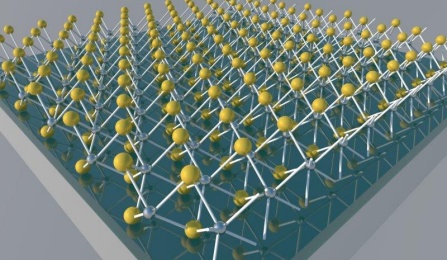
Researchers at the University of Buffalo have developed a photonic structure, or optical nanocavity, comprised of aluminum and aluminum oxide (Al2SO4). According to researchers, placing a single layer of molybdenum disulfide (MoS2) molecules atop this optical nanocavity can increase the amount of light the semiconducting material is able to absorb. A nanocavity is an arrangement of mirrors that allows beams of light to circulate in closed paths. These cavities help build things like lasers and optical fibers used for communications.
“The nanocavity we have developed has many potential applications,” says Qiaoqiang Gan, PhD, assistant professor of electrical engineering in the University at Buffalo’s School of Engineering and Applied Sciences. “It could potentially be used to create more efficient and flexible solar panels and faster photodetectors for video cameras and other devices. It may even be used to produce hydrogen fuel through water splitting more efficiently.”
Industry has kept pace with the demand for smaller, thinner, and more powerful optoelectronic devices, in part, by shrinking the size of the semiconductors used in these devices. A problem for energy-harvesting optoelectronic devices, however, is that these ultra-thin semiconductors do not absorb light as well as conventional bulk semiconductors. Therefore, there is an intrinsic tradeoff between the ultra-thin semiconductors’ optical absorption capacity and their thickness.
The nanocavity developed at the University of Buffalo is potential solution to this issue. A single layer of molybdenum disulfide is advantageous because its bandgap structure is similar to semiconductors used in LEDs, lasers, and solar cells, which is an advantage over another two-dimensional material, graphene.
Results are promising. The molybdenum disulfide-layered nanocavity can increase the amount of light that ultrathin semiconducting materials absorb. In turn, this could help industry to continue manufacturing more powerful, efficient, and flexible electronic devices.
“In experiments, the nanocavity was able to absorb nearly 70% of the laser we projected on it. Its ability to absorb light and convert that light into available energy could ultimately help industry continue to more energy-efficient electronic devices,” said Haomin Song, a PhD candidate in Gan’s lab and a co-lead researcher on the paper.
A paper on this technology, “MoS monolayers on nanocavities: enhancement in light-matter interaction,” was published in April by the journal 2D Materials. Zhiwen Liu, PhD, professor of electrical engineering at Penn State University Park, is the paper’s other co-lead author. Additional authors include UB graduate students Haomin Song and Dengxin Ji; and Penn State University Park students Corey Janisch (also a co-lead researcher), Chanjing Zhou, Ana Laura Elias and Mauricio Terrones. The research was supported by grants from the National Science Foundation, the U.S. Army Research Office, and the U.S. Air Force Office of Scientific Research.
